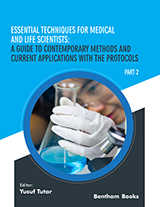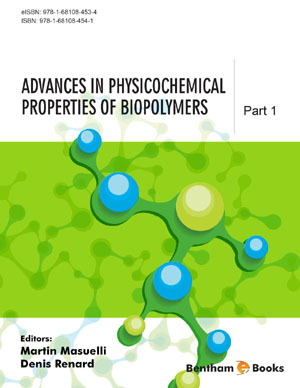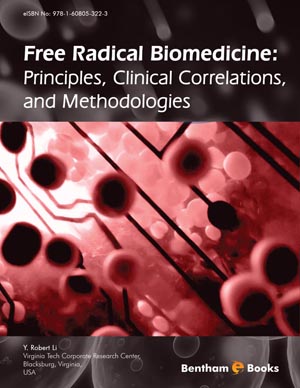Fourier-Transform Mid-Infrared (FT-MIR) Spectroscopy in Biomedicine
Page: 1-39 (39)
Author: Bernardo Ribeiro da Cunha, Luís Ramalhete, Luís P. Fonseca and Cecília R.C. Calado*
DOI: 10.2174/9789811464867120010004
PDF Price: $15
Abstract
Fourier-transform mid-infrared (FT-MIR) spectroscopy is a powerful technique that probes intramolecular vibrations of almost any molecule, enabling the acquisition of metabolic fingerprint of cells, tissues and biofluids (e.g. serum, urine and saliva, etc.), in a rapid (in minutes), simple (without or with minimum sample processing), economic (without consumption of reagents), label-free and highly sensitive and specific mode. Due to the flexibility of the technique, there are diverse modes of spectra acquisition, from classical transmission and transflection, to highthroughput measurements using micro-plates in transmission mode, to fiber optic probes coupled to Attenuated Total Reflection (ATR) detection, enabling in situ analysis, throughout micro-spectroscopy, with spatial resolution, enabling detection of residual analytes and imaging at the sub-cellular level. Due to the composition complexity of biological samples, the mid-infrared spectra are usually very difficult to interpret without the application of complex and sophisticated mathematical and statistical analysis routines, such as: spectra pre-processing methods to minimize noise and other non-informative data that compromise subsequent pattern recognition models; deconvolution methods to resolve overlapped spectral bands; methods to decrease data dimension and features extraction; supervised and non-supervised pattern recognition methods as those based on support vector machines and artificial neural networks. The present work reviews the main acquisition modes, pre-processing and multivariate spectral analysis used in FT-MIR spectroscopy, followed by the application of FT-MIR for the diagnosis of a multitude of diseases. FT-MIR spectroscopy constitutes one of the most promising biophysical techniques for analyzing biological samples, and consequently may be used for diseases prognosis, diagnosis and even for personalized treatment.
High Performance Liquid Chromatography (HPLC) – Theoretical and Practical Aspects
Page: 40-61 (22)
Author: Esen Tutar*
DOI: 10.2174/9789811464867120010005
PDF Price: $15
Abstract
High Performance Liquid Chromatography (HPLC) is a powerful chromatographic technique to separate, identify and quantify components in a mixture. HPLC has superior features such as versatility, safety, sensitivity, accuracy and low detection capability. It mainly utilizes a column that separates components, a pump that delivers mobile phase through the column and a detector that detects the eluted components from the column. Separation of components occurs based on the interaction between the stationary phase and the components. HPLC is divided into several classes depending on the stationary phase and the separation process such as normal phase, reversed phase, and ion chromatography. It has significantly contributed to many fields of science such as pharmaceuticals, foods, environment and forensics. This chapter mainly focuses on the theoretical and practical aspects of HPLC.
Raman Spectroscopy and Its Biomedical Applications
Page: 62-84 (23)
Author: Charu Arora*, Pathik Maji and P. K. Bajpai
DOI: 10.2174/9789811464867120010006
PDF Price: $15
Abstract
Raman spectroscopy is a significant characterization technique using inelastic scattering of light associated with molecular vibration to gather information about chemical fingerprints of tissues, cells or biofluids. Lack of sample preparation including chemical specificity and the ability to use advanced techniques in the visible or near-infrared spectral range have led versatility in biological applications of Raman spectroscopy. By Raman spectroscopy, the changes caused by diseases in tissues and organs can be accurately investigated and it is fast, non-invasive, economic and highly specific in comparison to other diagnostic and imaging techniques. It can provide quantitative molecular information for an objective diagnosis. Raman spectroscopy can measure both chemical and morphological information in samples and provide objective diagnosis for independent tissue samples of new patients. Some specific techniques and applications presented in this chapter which will demonstrate the potential of Raman spectroscopy for medical diagnostics, as well as the versatile interest in healthcare service.
Circular Dichroism
Page: 85-95 (11)
Author: Yusuf Tutar*
DOI: 10.2174/9789811464867120010007
PDF Price: $15
Abstract
Circular Dichroism (CD) is an absorption spectroscopy technique and measures left and right circularly polarized light difference of optical activity of asymmetric macromolecules. Unequal absorption of left and right circularly polarized light provides information about macromolecules depending on the spectral region. The far UV region provides data for secondary structure composition of proteins whereas near UV region provides data for tertiary structure of proteins. Furthermore, denaturation experiments provide stability parameters of proteins.
Transmission Electron Microscopy: Theory and Applications
Page: 96-116 (21)
Author: Charu Arora*, Sanju Soni and Pathik Maji
DOI: 10.2174/9789811464867120010008
PDF Price: $15
Abstract
Transmission Electron Microscopy (TEM) is a useful technique to explore the molecular structure, interactions and processes including structure-function relationships at cellular level using a variety of TEM techniques with resolution of one angstrom (Ǻ) 1 to 1000 Ǻ. Developments in modern science and technology, especially in the material science, depend significantly on microstructure characterization. In this context, novel characterization techniques are crucial to understand the properties of materials. The quality of TEM results is dependent on preparation of TEM grid. Experts are constantly working on optimization of milling parameters to reduce the potential artifacts. The resolution power of TEM makes it possible to visualize different objects with high quality images to study complex structures and tissue morphology. Thus, TEM has made a milestone towards the understating of cellular structure. This chapter includes introduction and theory of TEM including its instrumentation, sample preparation, and working applications.
Scanning Electron Microscopy: Theory and Applications
Page: 117-123 (7)
Author: Charu Arora*, Sumantra Bhattacharya, Sanju Soni and Pathik Maji
DOI: 10.2174/9789811464867120010009
PDF Price: $15
Abstract
In the present chapter, brief history, working principle, instrumentation and, recent applications of Scanning Electron Microscopy (SEM) have been enlightened. SEM is a highly sensitive and efficient magnification tool that exploits focused beams of electrons to obtain information allied to topography, morphology, and composition of materials. Utilization of SEM techniques in different fields, like various domains of materials science, forensic investigation, mechanical engineering, biological, and medical sciences has been discussed.
SEM-EDX: A Potential Tool for Studies of Medicinal Plants
Page: 124-141 (18)
Author: Iqbal Ansari, Muniyan Sundararajan, Ritesh Kumar, Sadanand Sharma and Charu Arora*
DOI: 10.2174/9789811464867120010010
PDF Price: $15
Abstract
Naturally obtained compounds from aromatic and therapeutic plants, herbs and shrubs have been playing a vital role in providing medicinal benefits for humans since the prehistoric period. Ancient Unani manuscripts, Egyptian papyruses, and Chinese writings have described the use of medicinal plants, herbs, and shrubs. Shreds of evidence can be found from Unani hakims, Indian Vaids, and European and Mediterranean cultures using herbs in medicine for over 4000 years. India has been known to be a rich repository of medicinal plants. The forests in India are the principal repository of various medicative and aromatic plants that are mostly collected as raw materials for the production of diverse medicine and perfumery merchandise. Treatments with these drugs are considered safe as there is minimal or no side effects. The Energy-dispersive x-ray analysis (EDX) technique is useful in the study of drugs and drug delivery. It detects nanoparticles, which are generally used to improve therapeutic performance of chemotherapeutic agents. EDX is also used for characterization of minerals accumulated in tissues. It can also be considered as a useful tool in element determination, endogenous or exogenous in the tissue, cell or any other samples. In the present chapter, potential applications of SEM-EDX in the study of valuable compounds present in medicinal plants, herbs and shrubs have been highlighted. Special reference was given to the rich biodiversity of medicinal plants found in the state of Jharkhand and the need for preserving it for the well-being of human-kind. The study provides information about the availability of some crucial minerals and phytoconstituents, which can be used to provide dietary elements and may also help in emerging new drug formulations. This chapter further highlights the role of electron microscopy coupled with analytical analysis, particularly SEM-EDX, in characterization of various primary and secondary elemental compositions. Since medicinal products based on the extracts from plants, herbs, and shrubs are ecofriendly, there is urgent need to promote extensive research in the field.
Introduction
This handbook covers some primary instruments-based techniques used in modern biological science and medical research programs. Key features of the book include introductory notes for each topic, a systematic presentation of relevant methods, and troubleshooting guides for practical settings. Topics covered in part 2 include: · Fourier transform mid-infrared (FT-MIR) spectroscopy · High performance liquid chromatography (HPLC) · Raman spectroscopy · Circular dichroism (CD) spectroscopy · Transmission electron microscopy (TEM) · Scanning electron microscopy (SEM) · SEM-EDX and its applications in plant science This book is a simple, useful handbook for students and teachers involved in graduate courses in life sciences and medicine. Readers will learn about the basics of featured techniques, the relevant applications and the established protocols.

















